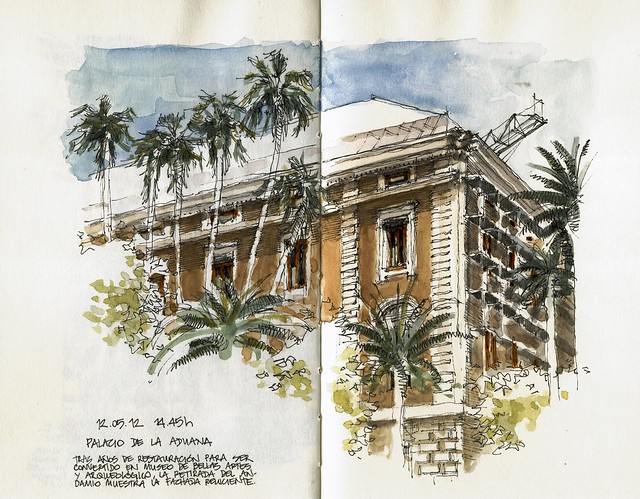
Tras un largo período de obras, el Palacio de la Aduana vuelve a mostrar su faz, una vez desmontados los andamios que ocultaban tras un halo de misterio los trabajos de rehabilitación del edificio y su conversión en la nueva sede del Museo de Málaga. A la espera del anhelado momento de poder visitar sus salas, mientras tanto podemos comenzar a disfrutar de nuevo de su rotunda presencia en el paisaje de la ciudad. Y ahora, más que nunca, tomo consciencia de las dos caras de la Aduana. La insólita manera en que su geometría inflexible parece insertarse a modo de cuña en el Paseo del Parque explica mucho sobre las difuminadas líneas del litoral malagueño, y transforma al que es una de los mejores construcciones de la ciudad en un Jano péteo que convierte la equivalencia entre sus cuatro fachadas casi idénticas en una ecuación imposible.
Al Norte, con severidad de palacio florentino, la Aduana mira al pasado, entablando un diálogo muy solemne con sus vecinos romanos y musulmanes, allí donde sus dos fachadas umbrías se rodean de piedras venerables.
Al Sur, en cambio, la Aduana enseña su cara más radiante; una explosión de vegetación subtropical atempera el rigor de su arquitectura, mientras las sombras juguetonas de las copas de las palmeras se persiguen sobre la superficie de sus muros.
Y, además, a la Aduana le han puesto un gorro. O más bien le devuelven el que le robó el tiempo una noche trágica de 1922, en un ejercicio de justicia volumétrica mediante el que se restituye su perfil original, y aunque donde antaño hubo teja hoy vemos chapa metálica, sospecho que no tardaremos en acostumbrarnos a su resplandeciente cubierta.
After a long period
of works, the Palacio de la Aduana (Palace of Customs) shows his face again, once the
scaffolding that
hid behind a
veil of mystery the rehabilitation of the building and its conversion into
the new home of the Museo de Málaga have been removed. While the desired time to visit its galleries comes, meanwhile we can enjoy again his fortright presence in the cityscape. Now more than ever, I become aware of the two sides of the Aduana. The unusual manner in which its inflexible geometry appears as a wedge inserted in the Paseo del Parque explains much about the blurred lines of the coast in Málaga, and transforms one of the best buildings in the town into a Janus, thus making the equivalence among its four almost identical facades an impossible equation.
To the north, with the severity of a Florentine palace, the Aduana looks to the past, holding a very solemn dialogue with its Romans and Muslims neighbors; it is in that place where the two shaded facades are surrounded by venerable stones.
To the south, however, the Aduana shows its most radiant side; there, an explosion of subtropical vegetation tempers the rigor of its architecture, while the playful shadows from the tops of the palms chase each other on the surface of their walls.
Besides, the Aduana has been suited with a new cap. Or rather the one time stole in a tragic night in 1922 is back. It is quite an exercise of volumetric justice in which its original profile has been restored. However, where you once found ceramic tiles now we see metal cladding, although I suspect that we will soon get used to its resplendent brand new roof ..
Besides, the Aduana has been suited with a new cap. Or rather the one time stole in a tragic night in 1922 is back. It is quite an exercise of volumetric justice in which its original profile has been restored. However, where you once found ceramic tiles now we see metal cladding, although I suspect that we will soon get used to its resplendent brand new roof ..
Beautiful sketch!
ResponderEliminarRestorations such as this have had mixed results in my city - Chennai. The Senate House, University of Madras was built in 1879 and had been allowed to age rapidly over the last few decades due to poor maintenance. I was restored with a lot of public participation a few years ago but is once again poorly maintained.
Thank you, Balaji! Thanks also for the reference on the Senate House in Chennai, it looks a very fine building and, like the Aduana, wonderfuly surrounded by dense vegetation (I have looked it up in wikipedia).
EliminarBy the way, I did not know the Indo-Gothic was also known as Indo-Saracenic revival. You have such marvelous architecture in your country, I definitely would like to visit it in the future.
Muchas gracias por tus palabras, Rocío. Ha sido una gratísima sorpresa descubrir tu blog y soy más bien yo el que siente envidia y admiración ante, por ejemplo, esa exquisita rama de almendro.
ResponderEliminarPor cierto, tuve la suerte de dibujar junto a Frank Ching el verano pasado en Lisboa... menudo maestro que es.